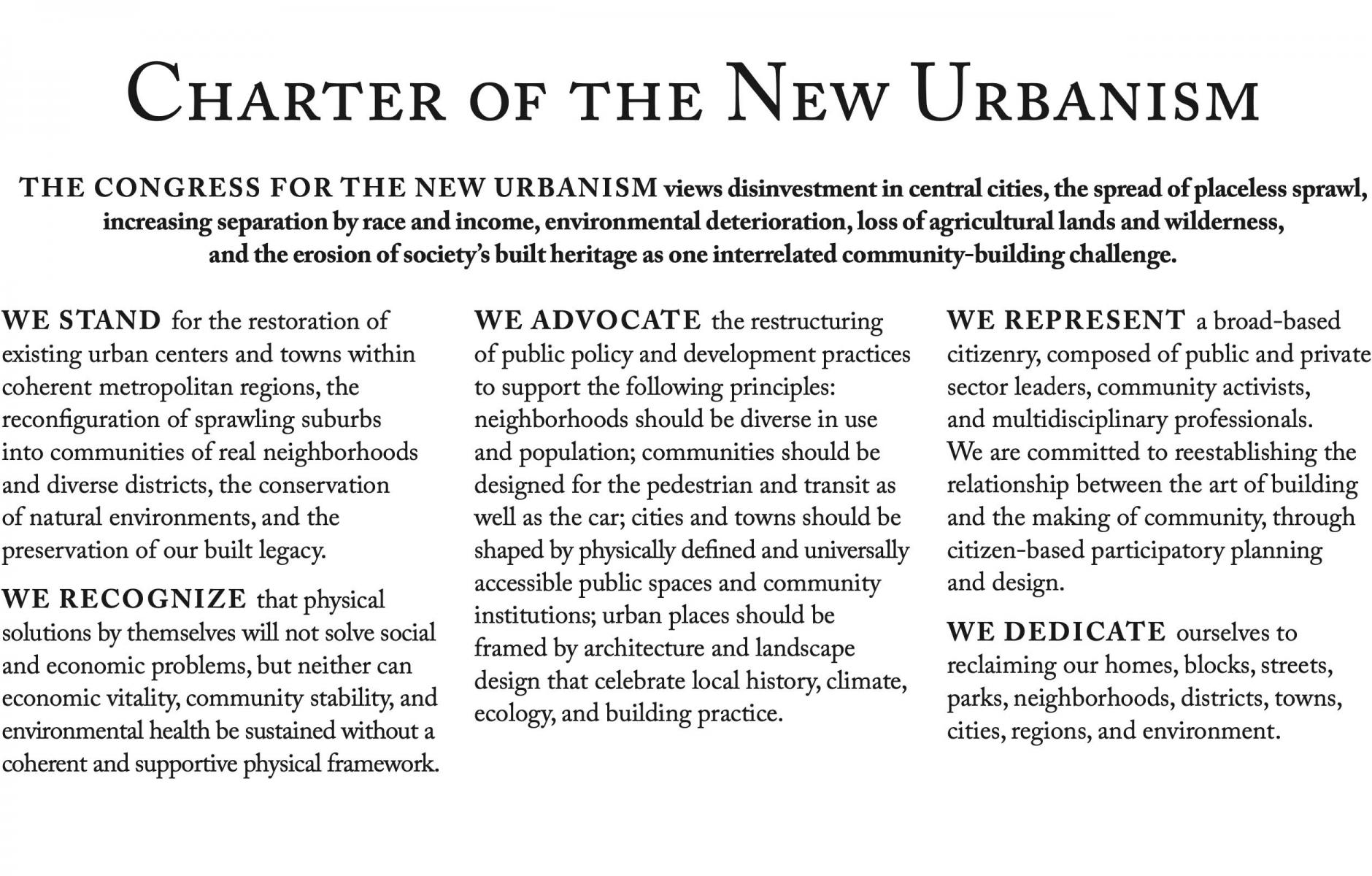
CNU and coherence in metropolitan regions
Good morning, New Urbanists, and welcome to the 33rd Congress for the New Urbanism!
I am Mallory Baches, and it is my honor to be the President of CNU and welcome each of you to Providence! Alongside my co-pilot, CNU’s Executive Director Margaret Gattis, I am proud to lead this organization that has such a clear and compelling vision for the world: of communities where people can know their neighbors, they can walk to their daily needs, they can play with their kids in a nearby park, and they can live a happy, healthy life no matter their age or race or income or career or lifestyle.
Our vision describes the kind of community that I was lucky to watch grow firsthand. Many of you may not know, I was one of the earliest residents of Habersham, which itself is one of the early greenfield examples of New Urbanism.
I bought my first house there. I brought my daughter home from the hospital there. I spent hours huddled in my ADU with a few of my neighbors, working out the plans to start a neighborhood school there. I hosted parties there, and went to baby showers there, and threw a prom there for one of my neighbors who never got to go to her own high school prom. I even held my father’s wake there. For sixteen years, my community was one example of the vision of the New Urbanism, where I was a neighbor to people working alongside me to help implement that vision—the urban designers, and the architects, and the landscape architects, and the developer, and the sales team, and the builders, and the shop owners, and even the county transportation engineer, believe it or not. And we were all neighbors to so many people who simply appreciated the quality of life that this work provides. Real people in a real community.
Building community is both what the members of CNU do every day through their work, and why the organization of CNU exists. Every year since 1993, our membership has gathered to reconfirm the community that is the New Urbanist movement, and to reinforce our commitment to the interrelated community-building challenge stated in the first line of our Charter:
Disinvestment in central cities, the spread of placeless sprawl, increasing separation by race and income, environmental deterioration, loss of agricultural lands and wilderness, erosion of society’s built heritage
That challenge is what each example of our work is attempting to offer—a hopeful solution. It is what we’ve returned here to Providence, in a continued attempt to solve. It is why we come together in community in here, to discuss and debate and learn and improve our practice, for the sake of every community out there.
It is true that our work has evolved since the earliest days of the movement. And it is true that some of the examples of the New Urbanist vision that have been built have been ridiculed for failing to live up to our stated ideals. Perhaps some of that ridicule has even come from some of you all here in this room.
In fact, that’s the hidden strength of the New Urbanism: every year, we gather as a community to learn from each other and to drive our collective impact further. We aren’t here to listen to the same presentations and have the same conversations we did, when the Congress was first held in Providence in 2006. No, we are here to urge ourselves to improve. We are curious about each other's perspectives, we are accountable for the impact of our work, and we endeavor to improve our practice year after year. It's what I love most about CNU.
Here in our 33rd year, we are working at a moment in history where so many of the foundations we might have assumed to be fixed even a year ago when we gathered like this in Cincinnati … those foundations are no longer as guaranteed, and many have been forever altered. The aphorism goes, change happens gradually, then all at once. With so much disorder happening in the systems and structures around us, what a year to be focused on:
Coherence.
For those of you attending your first Congress, I want you to know that the Congress Focus is more than a theme. At CNU, the Focus is the problem space we are hoping to address through the gathering of 1500 or so of our movement. It is the lens through which we approach the impact that we intend to make in our host region. And it is an aspect of the vision described by our Charter, that we know demands further work by the New Urbanist movement. At CNU33, the Focus for our gathering here in Providence is Coherence in the Metropolitan Region.
The Charter devotes an entire category of principles to guide our work at this scale. The region is the scale where multiple systems of urbanization collide and ideally, coalesce. The region is the scale where planning intersects policy, and it is where the right strategic reforms could have the ability fuel a radical increase in the number of places designed to reward walking to the store or biking to school or aging with dignity or cooperating with neighbors. I want to challenge each of you to use the content of this Congress as an opportunity to search for the ways that your own work contributes to regional coherence.
Because to make the impact we hope to make toward that vision we describe, we must do substantially more to take the New Urbanism to scale. And each of you are the connective tissue for how we begin to do so. Each of you brings a different sightline toward what we mean when we describe the city, the town, and the neighborhood. Each of you has a unique perspective on urbanism, grown from your own experiences within urbanism. And each of you has a community (or perhaps many communities!) where you can radicalize the newest group of New Urbanists.
CNU must lead this growth, by turning your expertise into powerful tools for collective action. A couple of examples that I’m thrilled to share…those who were at CNU32 in Cincinnati last year will remember the culmination of a year-long effort authorized by the CNU Board of Directors to amend the Charter of the New Urbanism. As you can see behind me, the seven additional principles to the Charter demonstrate a recognition that the context of our work has changed, and with the support of CNU members, our vision is now clearer. You’ll also recall the Climate Action Workshop from CNU32, where members of our movement with deep knowledge of urban response to the climate crisis gathered to coordinate strategy. Since then, CNU has signed with a publisher and will be developing a New Urbanist Climate Action Handbook based on their work. We will begin seeking contributions soon, and we’re excited to have the opportunity to compile the knowledge that the New Urbanist movement offers this challenge, and share it widely!
For those of you who were already in Providence yesterday, I hope you were already able to experience some of this growth here at CNU33! Right here in the Rhode Island Convention Center, CNU presented an all-day New Urbanism Open House, highlighting the ways that our vision matters in New England, and aimed at sharing our ideas with the community here in Providence. Next door in the Omni Hotel, CNU held our first all-day supplemental training for our Local Government staff and elected officials audience, supporting their critical role in facilitating and advocating the ideals of New Urbanism. And over at the Graduate Hotel, CNU hosted the Charter Awards Exhibit Hall and Project Presentations, celebrating the 25th anniversary of the program by helping folks learn from the experts about the projects that best exemplified the vision of the Charter of the New Urbanism this year.
Over the next three days, there will be Main Stage Conversations encouraging you to think critically about how we approach resilience and foster connection within our communities. You will hear from a Keynote speaker who is a thought leader in organizing the complexity of the regional scale of urbanism. You will have the opportunity to participate in a workshop aimed at collecting our shared knowledge of addressing housing access and affordability. You will be able to celebrate the book launch of a compilation representing some of the best, earliest illustrations of the principles we hold so dear, compiled in the just-released Art of the New Urbanism (volume 1 … with more to come!). And you’ll have the difficult task of choosing from dozens of sessions curated to help you increase your ability to contribute to coherence within the metropolitan regions where you practice.
These highlights in the Congress program—these innovations in the way that we support the New Urbanist community of practice—wouldn’t be possible without the support, dedication, and encouragement of so many. And that thanks starts with each of you. Your participation in this year’s Congress is profoundly necessary for CNU to be able to deliver on our mission.
I want to thank each of the sponsors that made this event possible—without your financial support, CNU could not provide the next three days of everything we love about the Congress. And I want to thank the CNU33 Local Host Committee, who have provided their local expertise to ensure that this Congress best represents the New Urbanist movement here in New England.
I want to thank the CNU Staff, who work behind the scenes to make all of what CNU provides possible. This organization operates with only a team of 10 individuals making sure that each of you receives membership support, and educational resources, and programmatic initiatives, and helpful communication, and timely reporting on the work of the movement. This year, especially, Margaret and I are so grateful to each staff member.
Finally, I want to thank the CNU Board of Directors for their leadership over the past year. As I reflected on yesterday’s board meeting where we thanked three members at the end of their terms, and welcomed four more who will be beginning theirs, I couldn’t help but be inspired by the commitment to the future of this organization that they are bringing to their own, often thankless, volunteer work. The future of this institution is in excellent hands.




